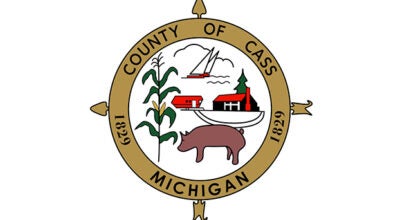Family takes root
Published 5:43 am Saturday, March 31, 2012
Lineage is everything to the Sparks family.
Penn Township farmers Lee and Carl Sparks are great-great-nephews of James E. Bonine, as in the Bonine House being restored on M-60 by the Cass County Underground Railroad Society.
Their mother was Lydia Rose Jones — Rose Sparks.
Rose’s father was Warner Jones, who died in 1967 at 97.
His father was Nathan Jones.
Nathan’s wife Lydia was a Bonine. In fact, Lydia’s brother was James E. Bonine.
Their parents were Isaac and Sarah Bonine.
Isaac came from Virginia by way of Tennessee and Indiana.
It’s the route the family’s centennial farm took before landing in the hands of Lee and Carl.
The farm’s official birthdate is somewhat ambiguous, even to the Sparks family, though they have a 1936 centennial farm certificate signed by Gov. G. Mennen Williams and Barbara Laing’s father, Prentiss Brown, suggesting 1836 with Isaac Bonine and 1987 sesquicentennial status, making it at least as old as Michigan.
Lee and Carl’s great-great-grandfather, George Jones, bought the land on which Lee’s house stands on Aug. 17, 1829, and died three years later at age 31.
The family figures the state celebrated its sesquicentennial by honoring all farms at least 150 years old — even those that may have been older.
Lee’s son Ken’s 4-year-old son Kaden, playing with toys in the living room, represents the seventh generation.
The farmhouse where Lee lives has been his only home.
“I lived in the house of the first county agent and the last. Grandpa (Warner) Jones was the first” and his father, Harold, the last.
Ken lives on Quaker Street, where Rose lived a half-mile west of Penn. That farmhouse is also known as the boyhood home of Capt. Iven Carl Kincheloe, the aviator for whom Dowagiac named Kincheloe Elementary School.
Kincheloe graduated from Dowagiac with the class of 1945. Rose taught at Kincheloe.
Penn, or Jamestown, in the geographic center of Cass County, was once a bustling community with a barrel factory and a grocery store.
Coming full circle
Today, the Sparks farm continues to produce crops and hogs, but started a year ago in a back-to-the future move, to milk cows as a dairy niche on their 1,100 acres, “which isn’t enough to support everyone to farm. Land’s kind of tight,” Carl said. “Ken and his brother, Daniel, got into the pasture-based dairy system. We started milking cows March 1, 2011, as a way to expand the farm without having to buy more land.”
“Rotational grazing” is facilitated by dividing 150 acres of pasture into five-acre paddocks.
Cows move systematically to a new pasture after every milking.
Dairy is seasonal, with calving in the spring.
Michigan Milk Producers Association trucks pick up milk every other day.
The truck, out of northern Indiana, also serves Andrews University’s 800-cow dairy in
Berrien Springs and hauls milk to Constantine or Benton Harbor.
Sparks milked 100 cows last year and will have more than 200 this spring.
High’s small herd at the corner of Gards Prairie and Hoffman streets is the closest to them at about a mile and a half. There’s another small dairy producer of 50 to 60 cows of about three years between Vandalia and Jones.
“There are still a lot of hog farms,” Carl said, “but you don’t see the hogs because they’re confined in buildings. We don’t make babies and farrow little pigs anymore. We’re actually a contract feeder. We don’t own the pigs, we finish them, which is one reason they’re not outside — leanness” and without parasites associated with living outdoors in the once-familiar huts.
“Many years ago, this used to be a dairy farm,” Lee said. “I milked four Guernsey cows with a milking machine” every morning before school in Dowagiac, where he graduated in 1961 with the last class at Central before Union High opened.
Historically, small family farms were less specialized than today.
“Every farm had chickens, hogs,” Carl said, to which Lee adds, “There are two apple trees left from the little fruit orchard.”
Cedarlee refers to the white cedars along both sides of the long drive and the fact the farm is on the “lee,” or west, side of them.
“There was a story that they were planting some of these cedars when they heard Abraham Lincoln was shot, so they stopped planting for a while,” Lee said.
“In all of our travels, I’ve never heard of another name like that,” Carl said.
“Penn Road used to run west of this house, which is why it’s so far from the road,” said Lee, who would put his own spin on East-West relations. “They wanted to avoid the marsh, so Penn Road ran to just south of this house, went around the marsh, then proceeded on (north) to Penn.”
Lee’s wife, Mariko, is originally from Japan.
“We met as pen pals,” she said. “I came from Japan 43 years ago and have lived here since.
Where I lived was very crowded.”
The living room of the farmhouse was built first with an upstairs and “Michigan basement” beneath it. “This part right here” with the dining room table was added later. The current kitchen came in a third expansion.
The old kitchen had an attached “wood house” for storing firewood to stoke the living room’s Dowagiac-made Round Oak Stove. Heating has been supplanted by geothermal.
“My mom was an only child, but she had a brother who died,” Carl said, “Lee’s the second-born. Ken’s the second-born and (Kaden) is his second-born son.”
Family heritage recognized
While there is no intrinsic value in a centennial designation, a sign in the farmhouse front yard identifies inhabitants as among a relative handful in Michigan’s rich agricultural history to be tilling land that has never been out of production or owned by anyone except the founding family.
Emily Asbenson, education and awards coordinator for The Historical Society of Michigan in Lansing, listed 96 Cass County farms that were at some point certified by the centennial farm program through 2006.
The compilation names Sparks’ Cedarlee Farm in Penn Township as originating in 1836 with Isaac Bonine.
“The list, however, is neither accurate nor inclusive. Many of the farms listed may no longer meet the requirements,” she said. “They may have been sold out of the family or may no longer be farmed, even if that is not noted on the list.”
Requirements
• Property must have been farmed without interruption for 100 years (centennial) or 150 (sesquicentennial).
• Farm must be at least 10 acres.
• Ownership must have stayed within the same family.







